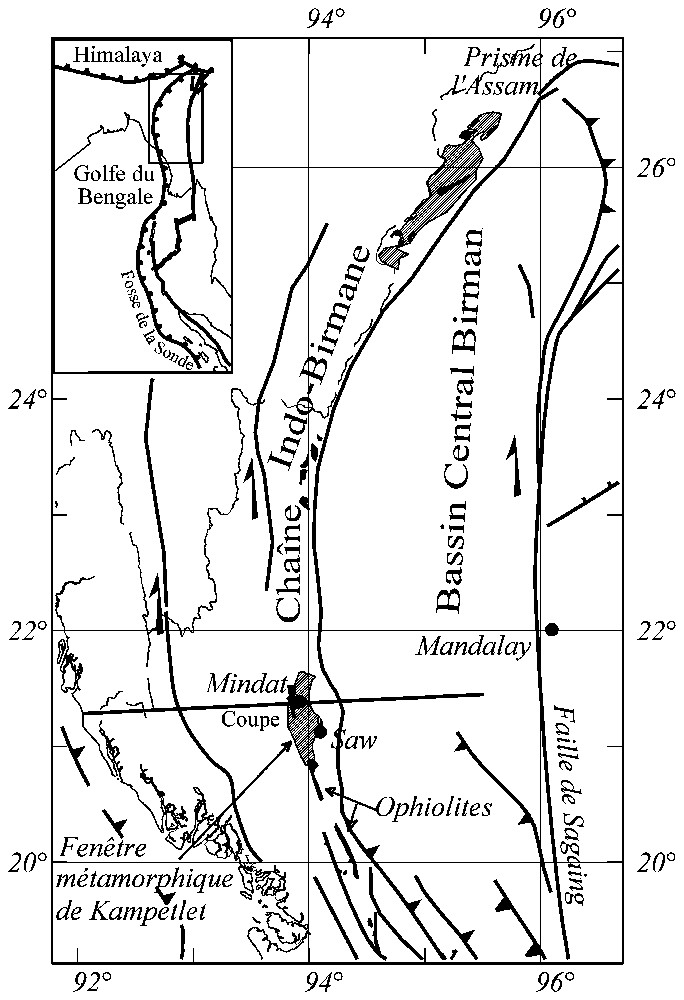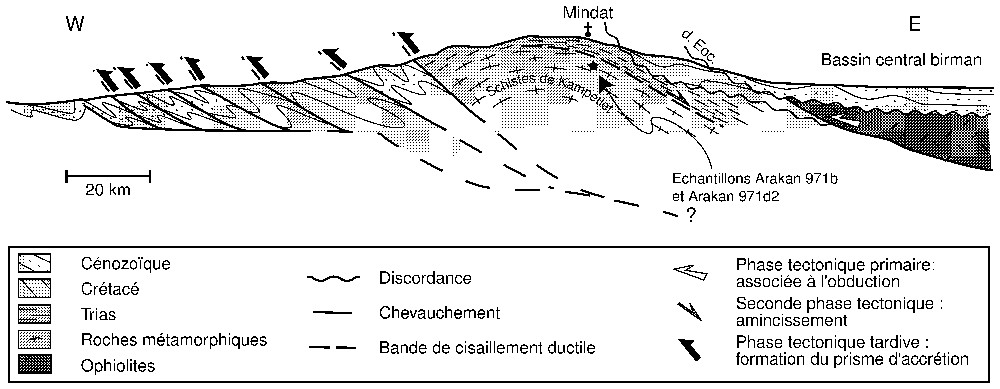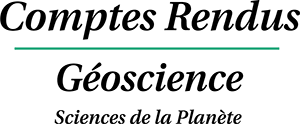Abridged version
1 Introduction
The Indo-Burma range, situated between the Eastern Himalayan Syntaxis and the northern termination of the Sunda Trench (Fig. 1, insert) has long been considered as a wedge resulting from the oblique convergence between India and Asia. However, the presence within the core of the range of a metamorphic dome (Kampetlet schists) associated with ophiolite, suggests that the range underwent a more complex geodynamic evolution inherited from the early stages of the India–Asia collision.

Grands traits structuraux de la Birmanie et localisation de la coupe.
Main structural framework of Myanmar and localisation of the cross-section.
The Indo-Burma range is indeed poorly known, the only existing data include rough maps and scarce structural and lithologic descriptions. Following mapping and sampling developed within the frame of the GIAC project (Geodynamics of the India–Asia Collision), we show that the metamorphic rocks of the Indo-Burma range underwent in the Early Tertiary a thermo-barometric evolution within a thick wedge underthrust beneath the ophiolite.
2 Geodynamic setting
The Indo-Burma range [2,9] is an arcuate sedimentary belt, mainly composed of Cenozoic rocks. It is interpreted as an accretionary wedge, resulting from the eastward subduction of the Bengal's oceanic crust. It is composed of two geological units (Fig. 2):
- • a large western belt of Cenozoic sediments that forms the present accretionary wedge;
- • an eastern narrow strip, composed of a variety of lithologies, including metamorphic rocks, ophiolites, Triassic schists and Late Cretaceous sediments, which constitute the internal zone of the range. In the region of Mindat (Fig. 2), the core of the metamorphics crops out. Clastic [2,4,11] deposits with limestone lenses of Campanian age unconformably rest upon the Triassic sequence, and are tectonically overlain by ultramafic bodies. All these series are deformed prior to the deposition of an Early Tertiary conglomerate grading upward to Middle Eocene fine-grained clastics of the central Myanmar Basin. The unconformity is in turn folded.

Coupe schématique de la chaı̂ne Indo-Birmane, montrant les relations entre les différentes unités décrites dans le texte.
Schematic cross-section of the Indo-Burma range, showing the relationships between the units described in the text.
These observations suggest that an ophiolite was obducted onto Mesozoic series between the Maastrichtian and the Eocene. We do not know the metamorphic grade that affected the Triassic series.
3 Paragenetic evolution and mineral chemistry
This study is focused on the Kampetlet schists, which result from an assemblage of metamorphosed mudstone, greywacke and basic rocks. They are affected by a N120° stretching lineation and a top-to-the-southeast shear that indicate ductile deformation. This lineation is underlined by three types of paragenesis, each one representing a specific geochemical system:
- • metapelites: quartz + albite + phengites + chlorites ± epidote;
- • metabasites: quartz + albite + actinolites + chlorites ± epidote ± relicts of magmatic pyroxenes ± relicts of magmatic feldspars, characteristic of the greenschist facies;
- • metagrauwackes: quartz + albite + crossites + chlorites ± epidote indicating a greenschist to blueschist transition, which indicates the peak of metamorphism.
The chlorites (Fig. 3C) are relatively siliceous (2.7 <Si<2.95) and their FeMg substitution vary between 0.65 < XMg < 0.8. Several chlorite generations may co-exist within the same thin section. The composition of phengites also varies, according to their structural position: high-pressure phengites are low in pyrophyllite compared to low-pressure phengites (Fig. 3D). The calcic amphiboles are Mg-actinolites (0.5<XMg<0.9) (Fig. 3A). The sodic amphiboles plot within the Mg-riebeckites and crossites fields (Fig. 3B).

Composition des minéraux métamorphiques. A: Amphiboles calco-sodiques. B: Amphiboles sodiques. C: Chlorites dans les métapélites. D: Phengites.
Composition of metamorphic minerals. A: Calco-sodic amphiboles. B: Sodic amphiboles. C: Chlorites in metapelites. D: Phengites.
4 – estimates
In order to quantify the P–T path of those rocks, we combined two kinds of constraints: the stability field of the main phases and multi-equilibrium calculations, essentially based on the mica-chlorite activity model [12,13] with the TWEEQ software (Thermobarometry With Estimation of Equilibration state) [3].
In the metabasites, the lineation is underlined by actinolite–chlorite associations that are characteristic of the greenschist facies.
In the metagreywackes, the chlorite–crossite–epidote–albite associations underlying lineation indicate the metamorphism peak: 8±1 kbar, 450±100 °C, in the transition between blueschist and greenschist facies.
In the metapelites, we observe several sites of chlorite–phengite association:
- • early associations present as inclusions in quartz or developed in a palaeo-foliation allow us to estimate low-pressure and low-temperature conditions: 4–5 kbar, 300–400 °C (Fig. 4a);
- • the main foliation or pressure shadows indicate the peak of metamorphism: 8–9 kbar, 350–450 °C (Fig. 4b);
- • in veins that cross the foliation, we observe the beginning of the exhumation process at 7–8 kbar, 420–480 °C (Fig. 4c);
- • late associations without preferential orientation finally give low metamorphism conditions: 4 kbar, 330 °C (Fig. 4d).

Trajet P–T des schistes de Kampetlet, estimé grâce aux calculs multi-équilibres sur les associations chlorite–mica et crossite–chlorite. Relations microtexturales entre les différentes associations chlorite–mica. Comparaison avec les modélisations thermiques de Bousquet.
P–T path for Kampetlet schists estimated by the multi-equilibrium calculation on chlorite–mica and crossite–chlorite associations. Microtextural relationships between the different chlorite–mica associations. Comparison with the thermal modelling of Bousquet.
Hence, we propose a P–T path (Fig. 4) in which retrograde conditions are close to prograde conditions.
5 Discussion
5.1 Geodynamic interpretation
During the prograde metamorphism, the geothermic gradient evolves from that of a ‘normal crust’ (30 °C km−1) to that of a thickened crust (18 °C km−1). This thickening (25–30 km) may have formed in a wedge where sediments were accreted.
This thickening phase was followed by a ductile crustal thinning, responsible for the N120° lineation that begins the exhumation of the micaschists. The cold retrograde path requires a mechanism allowing thermal re-equilibration, implying slow exhumation. An efficient way to do so is to invoke a thermal loss due to the presence of colder screens at the roof or/and at the base of the unit during its exhumation. Toward the top, the micaschists are in contact with non-metamorphic Triassic sediments. The pressure discrepancy between metamorphosed core and the above non-metamorphosed Triassic schists is of 7–8 kbar (about 25 km) and 350 °C. It may be explained by a large detachment that exhumed the metamorphics [7]. An alternate mechanism of cooling would be to assume that the slab also represents a cold thermal screen.
5.2 Wedge model
The comparison of the obtained P–T path and thermal wedge models performed by Bousquet [5] further implies some specific characteristics for the metamorphosed wedge. The relatively hot (18 °C km−1) thickened crust geotherm and the cold retrograde path suggest that:
- • the convergence velocity was slow (5 mm yr−1);
- • the sediments forming the wedge were highly radioactive (1 μW m−3);
- • a thinned continental crust (passive margin) was subducted down the wedge.
A convergence velocity of 5 mm yr−1 is reasonable if we consider only the trench-normal (east–west) component of the subduction of the India–Asia convergence. We take a radiogenic production of 1 μW m−3, compatible with a greywacke source [5]. No HT–LP rock having been reported in the area, we might discard metamorphism directly occurring beneath the ophiolite. However, we can suppose that the obducted ophiolite might have served as a backstop under which the accretionary wedge was in process of internal thickening (Fig. 5B). This model is close to the one proposed for HP–LT metamorphism in Oman [6,7].

Modèle d'évolution géodynamique de la région de l'Arakan.
Model of geodynamic evolution of the Rakhine region.
On the grounds of these observations, we can unravel three major phases affecting the Indo-Burma range:
- • a first compressive phase Late Cretaceous–Eocene, where the ophiolites were thrust over the Mesozoic metamorphic wedge at the time of the closure of the Meso-Tethys [8], which reminds the thrust disposition of the Zangbo ophiolite [1];
- • an extensive phase (ductile crustal thinning), coeval with the metamorphism along the Shan Scarp [4] and the subsidence of the observed in Central Myanmar Basin, deposited unconformably since the Eocene [10];
- • a second Pliocene compressive phase [10] that formed the present accretion wedge.
Therefore, the evolution of the Indo-Burma range bears similarities with the construction of the Himalayas, at least as far as the ophiolite emplacement and the beginning of the wedge formation are concerned. In contrast, the Indo-Burma range, because of its location away from the frontal convergence, may have preserved high-pressure facies.
1 Introduction
La chaı̂ne Indo-Birmane, située entre la syntaxe Est-Himalayenne et l'arc de la Sonde (Fig. 1), a subi une évolution géodynamique induite par la collision Inde–Asie. Si elle est actuellement considérée comme un prisme résultant d'une convergence oblique, son histoire est certainement plus complexe, puisque l'on retrouve, au cœur de la chaı̂ne, des ophiolites et un dôme métamorphique (schistes de Kampetlet). Son histoire est ainsi comparable à celle de l'Himalaya, la différence majeure entre les deux structures étant l'obliquité de la convergence dans l'Arakan.
Cette chaı̂ne est, jusqu'à ce jour, très méconnue, et les seules données dont nous disposons sont cartographiques, structurales et lithologiques. À la suite de la cartographie et de l'échantillonnage réalisés dans le cadre du projet GIAC (Geodynamics of the India–Asia Collision), nous montrons que les schistes de Kampetlet se sont sans doute métamorphisés dans un prisme d'accrétion situé à l'avant de l'obduction ophiolitique.
2 Contexte géodynamique
Le prisme de l'Arakan [2,9] est une chaı̂ne arquée, principalement formée de sédiments cénozoı̈ques. Il est interprété comme un prisme d'accrétion, lié à la subduction vers l'est de la croûte océanique du bassin du Bengale.
Il se compose de deux unités géologiques (Fig. 2) :
- • une large ceinture de turbidites cénozoı̈ques, qui compose la partie prisme d'accrétion proprement dite, à l'ouest ;
- • une zone plus étroite, à l'est, assemblage de roches métamorphiques, ophiolites, schistes triasiques et du Crétacé supérieur, qui compose la partie interne de la chaı̂ne.
Dans la région de Mindat (Fig. 1), cette zone interne affleure et révèle la présence de micaschistes (schistes de Kampetlet), non datés mais corrélés à des séries triasiques, dont nous avons étudié le métamorphisme.
Cette série de Kampetlet est recouverte, en discordance, par des dépôts détritiques du Campanien. Au nord de Mindat, on a observé des calcaires du Crétacé supérieur, en contact tectonique avec les ophiolites.
Au sud, dans la région de Saw, des ophiolites discontinues chevauchent ces séries. Le complexe ophiolitique comprend des serpentinites, des gabbros, des dykes stratifiés, des laves massives et en pillows, ainsi que des radiolarites.
Les ophiolites et le chevauchement sont recouverts en discordance par le conglomérat basal du Bassin central birman [4,11]. Ce conglomérat, de matrice éocène, reprend des galets de radiolarites, serpentinites et roches métamorphiques de la chaı̂ne.
Les discordances citées ci-dessus sont plissées, ce qui indique qu'une phase compressive tardive plisse les ophiolites et leur autochtone. L'ensemble vient chevaucher les séries cénozoı̈ques de la zone externe du prisme.
Sur la base de ces observations, on peut considérer que les ophiolites ont été obductées sur les séries mésozoı̈ques (Trias supérieur, Albo-Cénomanien et Campanien–Maastrichtien), qui forment le cœur de la chaı̂ne entre le Maastrichtien et l'Éocène, puisque le chevauchement est cacheté par un conglomérat éocène. De plus, la présence des micaschistes de Kampetlet, proches du contact avec les ophiolites obductées, pourrait indiquer que le Trias supérieur a été épaissi et métamorphisé pendant la phase d'obduction. Mais nous ne connaissons pas le degré du métamorphisme.
3 Analyse des paragenèses et chimie des minéraux
Les échantillons étudiés sont situés dans la région de Saw/Mindat, au sud de la chaı̂ne, et ont été prélevées dans l'unité des schistes de Kampetlet, qui forment le dôme métamorphique. Ces schistes sont un mélange de sédiments pélitiques, de roches basiques et de grauwackes.
Ces schistes sont affectés par une forte extension, caractérisée par une linéation minérale de direction N120° et un cisaillement ductile vers le sud-est. En lame mince, on retrouve très bien cette linéation, soulignée par trois sortes de paragenèses métamorphiques, chacune garante d'un système géochimique spécifique :
- • métapélites : quartz + albite + phengites + chlorites ± épidote ;
- • métabasites : quartz + albite + actinolites + chlorites ± épidote ± reliques de pyroxènes magmatiques ± reliques de feldspaths magmatiques ;
- • métagrauwackes : quartz + albite + crossites + chlorites ± épidote.
- • du quartz (en excès selon les calculs thermodynamiques que nous avons effectués), sous la forme de cristaux xénomorphes, aussi bien formant des veines précoces que dans la foliation ;
- • de l'albite dans la foliation, associée aux autres minéraux métamorphiques ; des chlorites siliceuses (Fig. 3C) (2,7<Si<2,95), dont la composition, en termes de substitution Fe–Mg, varie de XMg=0,65 à XMg=0,8. Plusieurs générations de chlorite existent parfois dans la même lame. On la retrouve aussi bien précoce, en inclusion dans les quartz ou dans la foliation associée à des micas ou des amphiboles, que tardive, poussant en plages sans orientation préférentielle, ou sous forme vermiculaire ;
- • des épidotes, en association avec les autres minéraux métamorphiques.
Dans les lames de pélites, on observe :
- • des phengites, principaux marqueurs du métamorphisme avec les chlorites ; les lames dont les phengites comportent une part importante de céladonite, contiennent des chlorites assez siliceuses (Si=2,9) ; en revanche, les lames dont les micas blancs sont plus riches en muscovite et pyrophyllite contiennent des chlorites dont le Si (=2,7) est nettement inférieur ; au sein d'une même lame, la composition des phengites varie également selon leur position structurale dans la lame ; ainsi, on peut nettement observer que les phengites de haute pression sont pauvres en pyrophyllite par rapport aux phengites de basse pression (Fig. 3D).
Dans les lames de métabasites, on trouve :
- • des actinolites relativement magnésiennes (0,5 <XMg<0,9) (Fig. 3A), associées, dans la foliation ou en associations réactionnelles autour de pyroxènes ou de feldspaths magmatiques, aux chlorites, à l'albite et aux épidotes.
Dans les lames de métagrauwackes, on observe :
- • des amphiboles sodiques, appartenant au champ des Mg-riebeckites et des crossites (Fig. 3B), qui sont associées à des chlorites, ainsi qu'à l'albite et l'épidote dans la foliation principale.
4 Estimations thermobarométriques
Afin de quantifier les conditions physiques (P,T) du métamorphisme, nous avons combiné deux méthodes :
Dans les métabasites, les reliques de pyroxènes et de feldspaths magmatiques sont prises dans une foliation formée par des associations actinolites–chlorites, caractéristiques du faciès schiste vert. Cependant, les calculs thermodynamiques ont révélé que ces associations n'étaient pas en équilibre.
Dans les métagrauwackes, on observe une linéation formée par des associations à chlorite, crossite, épidote, albite. On observe également des chlorites tardives, poussant en plages ou sous forme vermiculaire. Les associations à chlorites–crossites dans la foliation nous donnent le pic de métamorphisme : 8±1 kbar, 450±100 °C, à la transition entre les faciès schiste vert et schiste bleu.
Dans les lames de métapélites, nous pouvons observer plusieurs sites d'associations à chlorites et phengites :
- • en inclusion dans le quartz ou formant une paléo-linéation recoupée par celle N120 ; ce sont des associations primaires qui nous donnent des conditions de basse pression et basse température : 4–5 kbar, 300–400 °C (Fig. 4a) ;
- • dans la foliation N120°, observée sur le terrain ou dans les queues de cristallisation des porphyroblastes de quartz et d'albite qui marquent le pic de métamorphisme : 8–9 kbar, 350–450 °C (Fig. 4b) ;
- • dans des veines de haute pression qui recoupent la foliation, sans doute associées au début de l'exhumation, des schistes à 7–8 kbar, 420–480 °C (Fig. 4c) ;
- • surimposées à la foliation et sans orientation préférentielle, sans doute tardives et associées à la fin de l'exhumation ; elles donnent des conditions de basse pression et basse température (4 kbar, 330 °C ; Fig. 4d).
À l'aide des conditions P–T estimées par différentes générations de chlorite et phengite, nous proposons un chemin P–T, dans lequel les conditions du chemin rétrograde sont proches de celles du chemin prograde (Fig. 4).
5 Discussion et conclusions
5.1 Interprétation géodynamique
Lors du métamorphisme prograde, on passe d'un gradient géothermique de croûte normale de 30 °C ·km−1 à un gradient de croûte épaissie de 18 °C km−1. Cette phase d'épaississement relativement important (25–30 km) se fait vraisemblablement dans un prisme où les sédiments viennent s'accréter.
Cette phase est ensuite suivie d'un amincissement crustal ductile, qui débute l'exhumation des schistes. Le chemin rétrograde froid implique un mécanisme permettant l'échange thermique, nécessairement lié à une exhumation lente. Ce chemin nécessite également la présence d'un écran thermique qui refroidit les roches au cours de leur exhumation, soit par le toit, soit à la base, soit les deux. À leur toit, les schistes métamorphiques sont en contact avec des sédiments triasiques non métamorphiques. Le saut de métamorphisme entre la partie métamorphique au cœur et la partie non métamorphique au toit représente une valeur de 7–8 kbar (soit 25 km environ) et 350 °C. Ce saut correspond nécessairement à un contact tectonique important de type détachement (bande de cisaillement ductile), qui exhume les roches métamorphiques [7]. Une alternative serait de penser que la plaque plongeante représente aussi un écran thermique.
5.2 Modèle de prisme
Si l'on compare le chemin P–T obtenu et les modélisations de prismes réalisées par Bousquet [4] (Fig. 4), nous pouvons déduire certaines caractéristiques spécifiques pour le prisme dans lequel se sont formés ces schistes. Le géotherme de la croûte épaissie étant relativement chaud (18 °C km−1) et le chemin retour assez froid (pas de décompression isotherme), il en résulte que :
- • la vitesse de convergence effective est relativement faible, de l'ordre de 5 mm an−1 ;
- • les sédiments constitutifs du prisme sont assez radioactifs (1 μW m−3) ;
- • le modèle testé le plus représentatif de nos résultats implique qu'une croûte continentale amincie passe en subduction sous le prisme.
Une vitesse de convergence lente, de 5 mm an−1 peut être obtenue en ne considérant que la composante perpendiculaire à la fosse du mouvement entre l'Inde et l'Asie (soit la composante est–ouest). Une production radiogénique de 1 μW m−3 semble compatible avec des grauwackes. Puisque aucun métamorphisme de HT–BP (semelle amphibolitique) n'a été décrit dans la région, nous écartons l'hypothèse d'un métamorphisme directement sous la semelle des ophiolites. Toutefois, on peut penser que l'ophiolite obductée appartient au butoir contre lequel viendraient s'épaissir les sédiments (marge passive orientale du bloc Ouest-Birman). Le panneau plongeant serait alors une croûte continentale amincie (Fig. 5B). Ce modèle se rapproche de celui proposé pour le métamorphisme de HP–BT de la fenêtre de l'Hawasina, en Oman [6,7].
5.3 Modèle d'évolution géodynamique
Trois phases tectoniques principales ont affecté la chaı̂ne Indo-Birmane (Fig. 5A).
1. Une première phase compressive, Tardi-Crétacé à Éocène, qui permet le chevauchement des ophiolites des Nagalands sur un Mésozoı̈que autochtone. Le métamorphisme des schistes de Kampetlet est probablement lié à cette première phase. L'épaississement se ferait dans un prisme constitué à l'avant ou sous les ophiolites. Il est difficile de discerner si cette obduction est associée à la fermeture de la Méso-Téthys [8], ce qui rappelle le dispositif en chevauchement des ophiolites du Zangbo [1], ou s'il faut la relier à la convergence Inde–Birmanie.
2. Une phase d'amincissement crustal, qui forme le métamorphisme de HT depuis l'escarpement Shan jusqu'à Mogok, après le passage de l'Inde [4], et fait subsider le Bassin central birman. Ce bassin met en évidence une migration d'ouest en est des dépôts centres. Les dépôts les plus anciens sont éocènes (molasses détritiques : dépôts proximaux de piémont). Ceci implique que la phase de rifting, initiée à l'Éocène à la suite de l'obduction, se poursuit jusqu'au Miocène [10].
3. Une seconde phase compressive au Pliocène [10], qui fait chevaucher vers l'ouest le socle métamorphique, les ophiolites et le bassin qui les recouvre sur les unités paléogènes et néogènes externes du prisme. Cette phase correspond à la construction du prisme actuel.
Il est difficile de préciser si l'exhumation des schistes est :
- • un phénomène localisé au prisme d'accrétion (phase 1), qui se fait en arrière de l'épaississement ;
- • un phénomène lié à une extension oligocène tardive (phase 2).
L'exhumation se faisant localement le long d'une bande de cisaillement, il semble légitime de penser qu'il s'agit d'un phénomène local, lié à la dynamique et à l'équilibre du prisme. Toutefois, la linéation N120° présente une direction très proche de l'étirement oligocène qui ouvre les bassins centraux birmans à la suite de la migration de l'Inde vers le nord. On est donc tenté, soit de relier l'exhumation des schistes à cette phase de rifting, soit de supposer que les événements sont coaxiaux.
Ainsi, l'évolution de la chaı̂ne Indo-Birmane présente des similarités avec celle de l'Himalaya, au moins jusqu'à la mise en place de l'ophiolite et le début de la formation du prisme éocène. À l'inverse, la chaı̂ne Indo-Birmane a préservé les faciès de haute pression, peut-être à cause de sa position loin des régions de convergence frontale.
Remerciements
This work has been done within the framework of the GIAC project (Geodynamics of the India–Asia Collision), a collaborative scientific project between the ‘École normale supérieure’ of Paris, the universities of Yangon, Dagon and Mandalay in Myanmar, supported by TMEP. We thank Teddy Parra for his helpful advices in the thermodynamic calculations for the petrographic analysis.


